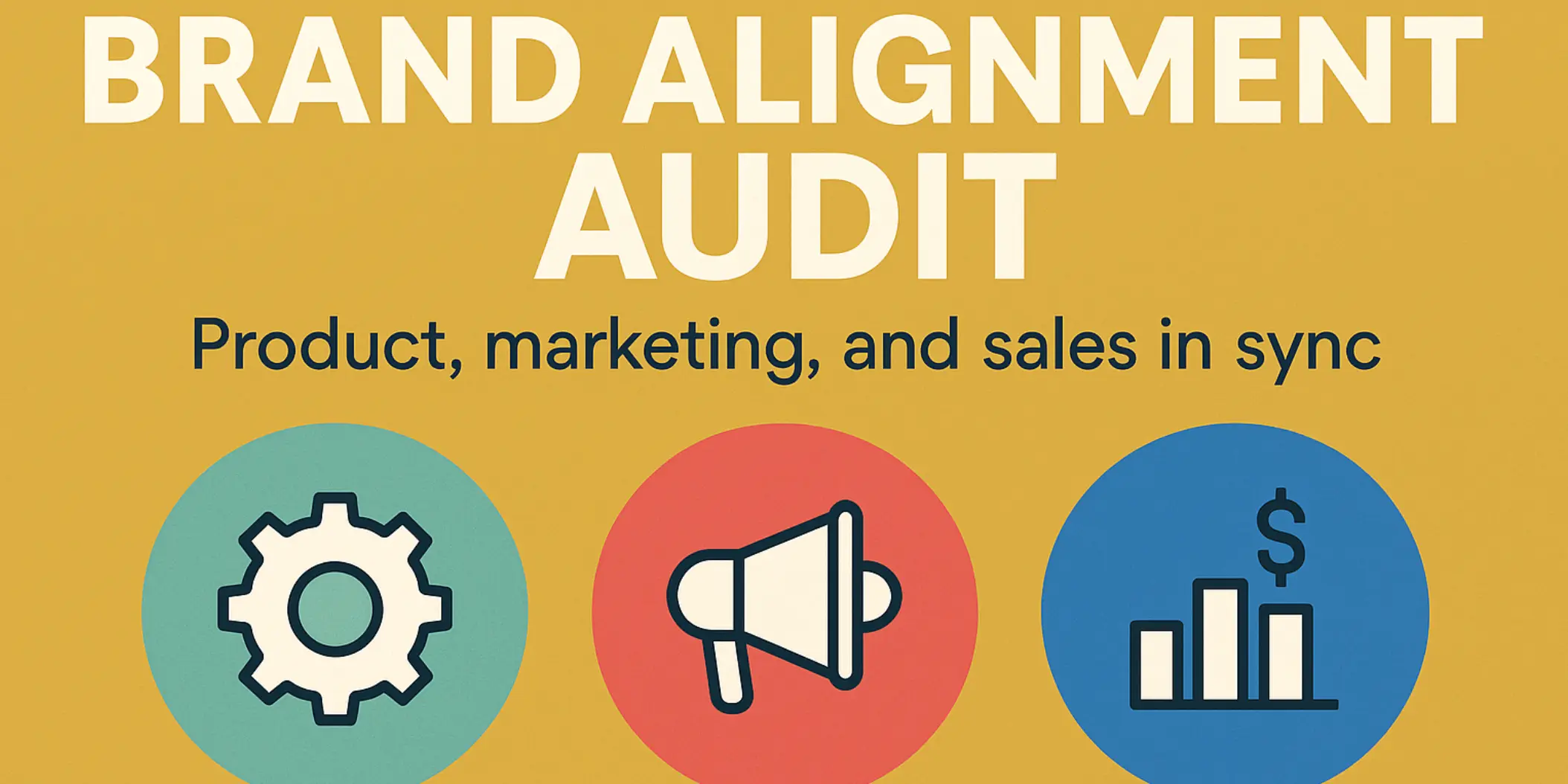The Brand Alignment Audit: A Checklist for Ensuring Product, Marketing, and Sales Speak the Same Language
Updated on
Published on

Brand alignment is the operating system that keeps product truth, marketing story, and sales promises in sync. When even one team drifts, buyers feel the gap and trust erodes. The goal is simple: one positioning, one vocabulary, and one set of proofs that show up everywhere. Below is a pragmatic audit that nails alignment within product, marketing and sales, with insider tactics, templates, and checkpoints you can run every quarter.
At a glance (our checklist)
- One page that states the promise, three pillars, and three proofs everyone repeats.
- A shared word list so product, marketing, and sales use the same terms.
- One proof library with metrics, quotes, and visuals that anyone can grab fast.
- Product flows captured in three steps and reused in the site, deck, and demo.
- Clear ICP and top use cases, each with a short story, a proof, and a CTA.
- Pricing and plan language matched across website, app, and sales quotes.
- A short sales pitch and objection answers that mirror the brand wording.
- Monthly check-in and a simple dashboard to spot drift and show what’s working.
.webp)
1) Positioning stack audit
Start with a one-page “positioning stack” that ladders from a single promise to three product pillars and three proof stories. Your homepage H1, product pages, sales deck headlines, and the first 30 seconds of the demo should all express the same idea in slightly different words. Insiders treat this page like source of truth: any new claim must map to a pillar or it does not ship. This is the fastest way to ensure brand alignment before campaigns or features go live.
- Action: write the one-sentence promise, 3 pillars, and 3 short proofs on a single doc.
- Check: can a rep deliver a 10-second intro using the same nouns and verbs as the site?

2) Message map and vocabulary guardrails
Most misalignment hides in vocabulary. Publish a message map that links pains → promises → proof, then enforce a do/do-not terminology list. Retire synonyms that confuse buyers and standardize the nouns that matter. Insider tip: put the message map into your CMS and sales enablement tool so copy, ads, and talk tracks pull from the same source. Consistency improves attribution and recall across channels (Nielsen: Creative impact).
- Action: create a two-column “use / avoid” glossary with examples in context.
- Check: run headline reviews on ads, hero sections, and one-pagers against the map.
-1.webp)
3) Proof library that anyone can find in 10 seconds
Buyers do not buy adjectives, they buy evidence. Build a shared “proof library” with three proof assets for each pillar: quantified outcome, named customer quote, and a visual before/after. Tag every proof with pillar, industry, and stage so product, marketing, and sales pull the same receipts.
- Action: make a single folder with proofs mapped to pillars and use cases.
- Check: require “one claim, one proof” in every deck, page, and script.

4) Product to narrative alignment
Great marketing can only sell what the product can demonstrate. Sit product, marketing, and sales together and map each pillar to a three-step in-product workflow. Capture exact screens as GIFs, then place them in the site, deck, and demo script. Insider move: use the same on-screen labels and microcopy across product and marketing, so the words a buyer reads on the website match the UI they see minutes later.
- Action: record a 3-step screen sequence per pillar with a one-line caption.
- Check: update GIFs and screenshots in decks and pages whenever UI changes.

5) ICP and use case clarity
Alignment fails when teams pursue different buyers. Lock your ICP and the top three use cases for the next two quarters. Each use case gets a one-paragraph story, a metric-based proof, and a “next best action” CTA for sales. Insider tip: mine win/loss interviews and call transcripts to extract buyer language and objections, then reflect those words in headlines and talk tracks. Conversation-level insight improves close rates when it feeds messaging directly (Gong Labs: Talk track insights).
- Action: write three use-case one-pagers with identical structure and verbs.
- Check: verify ads, emails, and outbound openers reference the same pains.
6) Pricing, packaging, and promise
Your pricing page, in-app plans, and sales quotes must tell the same story. Create a “truth table” for each plan: value, features, limits, and outcomes. Remove language that implies value a plan cannot deliver. Insider move: align plan names with your pillars to reinforce positioning and reduce later discount pressure, which often comes from mismatched expectations.
- Action: audit plan pages and quote templates side by side for copy parity.
- Check: test a standard quote against the public pricing page and fix mismatches.

7) Sales narrative and talk tracks
Give sales a layered narrative that starts with the buyer’s problem, states the promise in your brand words, and proves it in two lines. Record a two-minute baseline pitch and publish the transcript. Insider tip: write objection handlers that reuse the same nouns and verbs from the message map; cognitive fluency signals one brand, one truth. Calls convert better when reps echo the same language buyers saw in marketing (Nielsen: Creative impact).
- Action: create a “golden call” library with short clips for each pillar and proof.
- Check: coach to the script, not around it, and review five calls weekly for drift.
8) Content and campaign alignment
Every asset should map to a pillar and a use case. Build a quarterly content grid that pairs each story with its proof and its sales follow-up. Insider move: enforce “proof proximity,” placing quantified outcomes within one scroll of the claim. Measurement-wise, judge creative on recognition and message pull-through, not only clicks. The IPA’s body of work shows creative consistency compounds results across bursts and quarters (IPA: Effectiveness).
- Action: tag each blog, case study, webinar, and ad to a pillar and use case.
- Check: gate only assets that sales actually uses to progress deals.

9) Website and demo sync
The website sets expectations; the demo confirms them. Pair each homepage claim to a specific demo moment and show the stopwatch for “set up in minutes” or the calculator for “lower cost.” Insider tip: script the demo to mirror homepage section order, so buyers experience the same narrative twice in different mediums. This is the fastest path to trust.
- Action: build a three-minute “homepage-mirrored” demo path.
- Check: run a monthly site-to-demo review and fix any copy or order mismatches.
10) Post-click and post-sale experience
Onboarding, lifecycle emails, and support scripts are part of the brand alignment story. Keep tone, promises, and next steps consistent with what marketing and sales sold. Insider tip: deliver the first proof in the first session, then ask for a quote at day 30 using your brand words; this feeds the proof library and reinforces the vocabulary.
- Action: ship an in-app checklist that achieves a measurable “first win.”
- Check: capture a customer quote at day 30 that reuses your promise and pillar terms.

11) Feedback loops that prevent drift
Alignment breaks slowly. Short loops catch it early. Use call recordings, win/loss notes, support themes, and roadmap reviews to spot new objections or vague promises. Insider move: publish a monthly “drift report” that lists what changed in the field, the decision taken, and the updated copy or proof. Pipeline quality rises when these loops are tight (Gong Labs: Talk track insights).
- Action: run a one-hour cross-team review on the top three frictions.
- Check: update the message map and proof library after each review, then announce changes.
12) Shared dashboards that track pull-through
Measure message pull-through, not just clicks. Track how often pillars appear in calls, which proofs get used, and how quickly buyers reach the promised value. Create one slide per month that connects alignment metrics to revenue. Over time, teams see that consistent messages, strong creative, and proof proximity move the same numbers executives care about (IPA: Effectiveness).
- Action: build a simple dashboard for pillar mentions, proof usage, and time-to-value.
- Check: share the slide at the all-hands and call out specific copy or proof updates that drove lift.

.webp)
FAQ
What is brand alignment and why does it matter?
Brand alignment means product, marketing, and sales describe the same value in the same language and can prove it on demand. It matters because buyers detect inconsistency quickly and penalize it with lower trust and slower decisions.
How do I run a brand alignment audit in 90 minutes?
Read the homepage, pricing page, and deck headlines, then listen to three recent sales calls. Write one promise, three pillars, and three proofs. Mark any copy or claims that do not map and fix the top five this week. Re-record the baseline pitch to lock language.
How can a product help align with marketing and sales?
Product should publish a three-step click path for each pillar, the in-product labels that match marketing copy, and a metric for time-to-value. This lets marketing tell the story and lets sales prove it in minutes.
How often should we check alignment?
Quarterly is a good rhythm. Run the checklist after launches, pricing changes, and leadership shifts. Keep the message map and proof library as living documents and tie them to your content calendar and enablement hub so updates propagate automatically.
Make Consistency Your Competitive Edge
Brand alignment is a system, not a slogan. When product, marketing, and sales share one promise, one vocabulary, and one set of proofs, every touchpoint pulls in the same direction. Use the checklist to lock the basics, keep monthly loops tight, and let evidence guide updates. Do that, and the story buyers hear is the story they experience.







